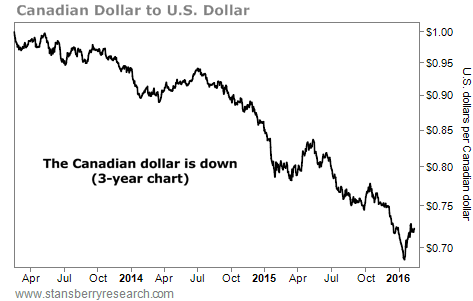| Home | About Us | Resources | Archive | Free Reports | Market Window |
These 13 'Must-Read' Resources Will Make You a Better InvestorBy
Wednesday, February 17, 2016
"What are the things you always find time to read?"
That's the question I posed to the entire Stansberry Research analyst community earlier this month.
We create content of value for you, our dear readers, by doing a tremendous amount of reading ourselves. Unfortunately, it doesn't all pack the same punch.
For instance, I've got a stack of popular financial magazines on my desk. For every three to five issues I read, I know I'll find one, two, maybe three really interesting or useful articles. The problem is, reading through that many issues will consume at least an hour or two of my most precious resource: time.
That's why I was curious to learn what reading material my colleagues consider high priority.
Below is a compilation of what they told me – the top media resources Stansberry Research analysts rely on for useful and interesting reading.
In your quest to become a better investor, I suggest you give them serious consideration as well...
Daily News Coverage
All of us consider the 1) Wall Street Journal required daily reading. Personally, I prefer the digital version, which I can usually scan within 15-20 minutes to get a good handle on the day's most important financial stories. Extreme Value editor Dan Ferris also regularly reads the 2) Financial Times to get a second perspective on many of these stories.
The Wall Street Journal's sister publication 3) Barron's is also required reading. The print version is published each weekend, but the website is refreshed daily with commentary from various Wall Street analysts. The website's search function is often an excellent resource when doing company-specific research.
Many of us also scan the digital version of 4) Investor's Business Daily each day. This publication focuses on industries and companies that are growing faster than the broader market, such as those in technology and biotech. You'll also find regular coverage of the latest (and pending) top initial public offerings.
Dan, Brian Weepie of the Stansberry Resource Report, and I all agree that 5) Bloomberg is another important daily news source. You can sign up here to get the latest breaking news delivered right to your inbox.
Finally, Dave Lashmet of Stansberry Venture relies heavily on 6) Google News. Here's why, in his words...
Monthly Periodicals
Dave finds 7) The Economist, which is actually published weekly, a top read. He told us...
Brian, Dan, and many other Stansberry analysts are fans of 8) Grant's Interest Rate Observer. Its coverage of monetary policy and related topics is second to none. I've been reading 9) Richard Maybury's Early Warning Report for more than a decade. Maybury has developed a geopolitical model that reflects his extraordinary grasp of world history. He uses it to frame current events.
For interesting, non-investment-related reading I also like 10) Smithsonian magazine. Month after month, this publication is packed with fascinating stories that go far beyond basic American history.
Other Media
For Dan, 11) Howard Marks' – founder and chairman of Oaktree Capital – memos are at the top of his "always make time to read" list. Bryan Beach of Stansberry's Credit Opportunities is also a fan.
I couldn't agree more. That cliché about someone being wise enough to have forgotten more than you'll ever know is true for Marks. No one packs more investment wisdom per sentence into a missive than he does.
You can access 25 years of his memos here, and receive an e-mail notification whenever a new one is posted.
Bryan Beach and others also consider 12) Warren Buffett's annual shareholder letter a must-read. You can read every letter he has written since 1977 here.
Speaking of Buffett, 13) The Warren Buffett Way – Investment Strategies of the World's Greatest Investor by Robert G. Hagstrom had a huge influence on my early investing career. I still highly recommend it.
In summary... Make the most of your research time. Choose media resources like those we've noted that are most likely to be consistently insightful, useful, and interesting.
Good investing,
Mike Barrett
Further Reading:
"Over 99% of the investing books out there aren't worth the time it takes to read them," Dan Ferris says. "This is a major problem for people who want to build a basic investment education." For a list of the best books you should add to your list today, click here.
And for a "bonus" book to check out, consider Philip Tetlock's Superforecasting: The Art and Science of Prediction. In our quest to become great investors, our job is to see into the future better than others, and buy today where the profits will be tomorrow. Learning to think like the extraordinary forward thinkers that Tetlock calls "superforecasters" will help in that quest. You can learn more about this fascinating subject in this essay from Mike.
Market NotesTHIS FOREIGN CURRENCY IS DOWN BIG Today's chart highlights the long-term downtrend in the Canadian dollar...
Canada is rich with natural resources like oil, natural gas, copper, gold, and uranium. In fact, natural resources account for almost 20% of its GDP. The sale of oil and gas is by far the largest source of Canada's natural resource revenue. As you might expect, that's a major problem right now. Over the past year, crude oil prices are down 45%, while natural gas has dropped 30%.
On top of that, Canada is also hurting right now in other areas. Canadian banks (which have funded drilling and exploration operations) have struggled. The Canadian Imperial Bank of Commerce (CIBC) – one of the largest banks in Canada – recently downgraded its 2016 economic outlook for the country. The real estate sector is down, too. With a sluggish economy, folks have less money to spend on homes.
All of this has put downward pressure on the Canadian dollar. While Canada's currency has risen slightly over the past month, it's still down big over the long term. Over the past three years, the Canadian dollar has weakened nearly 40% against the U.S. dollar, as you can see below. It was at parity in 2013, but just three years later, it takes 1.39 Canadian dollars to buy one U.S. dollar. That's a huge, bearish move for a major currency...
 |
Recent Articles
|



